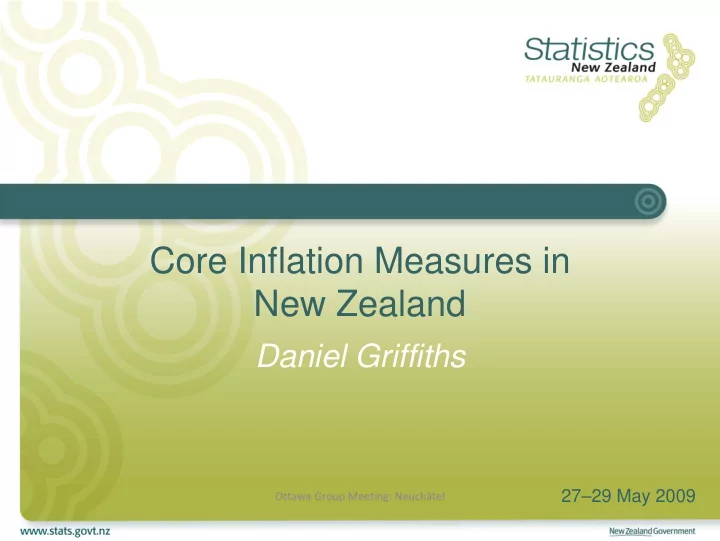

Core Inflation Measures in New Zealand Daniel Griffiths 27–29 May 2009 Ottawa Group Meeting: Neuchâtel
Monetary backdrop to core inflation Inflation targeting Reserve Bank Act (1989) Policy Targets Agreement (PTA)
Policy Targets Agreements Defines the target of monetary policy • Stabilisation of the ‘general level of prices’ Specification and measurement of price stability • Monitored via a range of price indexes Important element in monetary policy transparency and accountability
Target measures of inflation Housing adjusted price index ‘Underlying inflation’ CPI less credit services CPI all groups Other considerations to the target • Avoiding instability in output, exchange rates and interest rates
Caveats within the PTA Natural disaster Significant changes in terms of trade Changes in: • direct and indirect taxes • government and local body charges Move towards more general approach
Desirable qualities of core inflation measures Robust and unbiased – efficient in distinguishing between persistent and transitory inflation, and not be biased relative to the target measure of inflation Timely Credible Verifiable
Other properties of core inflation Simple Picks up persistent changes in inflation Leads or coincides with measured inflation Smooth Low prediction error for measured inflation
Measures of core inflation Exclusion-based approaches Decomposition measures Statistical measures
Exclusion-based measures Classification-based measures Exclusion of volatile components Exclusion based on economic priors Criticisms of exclusion-based measures
Consumers Price Index CPI all groups, food, petrol, and household energy Base: December 1998 quarter (=1000) Index 2500 CPI all groups Food Household energy Petrol 2300 2100 1900 1700 1500 1300 1100 900 D M J S D M J S D M J S D M J S D M J S D M J S D M J S D M J S D M J S D M J S D 98 99 00 01 02 03 04 05 06 07 08
Decomposition measures Tradables and non-tradables (domestically generated inflation) Central and local government charges Goods and services
Statistical measures Trimmed means Weighted percentiles Double-weighted median Exponentially smoothed (ES)
Trimmed means and weighted percentiles Trimmed means (5, 10, 15, 20, 25, 30) Percentiles (10 th , 25 th , 50 th , 75 th , 90 th ) Choice of annual measure: • Annual percentage change • Compounding quarterly changes
Stochastic theory and factor modelling = μ ε = 1 0 01 01 p / p f ( , )( n 1 ,....., N ) n n n π = χ + ε jt jt jt π = χ + χ + ε L S jt jt jt jt Where: the long-run component X L (core inflation) short-run component X S
Characteristics of core inflation candidates (ranked) Core Simple Picks up Leads or Unbiased Smooth measure persistent coincident changes in inflation Trimmed 1 3 1 1 3 mean ES measure 1 2 3 1 1 Factor 3 1 1 1 2 model Source: Holden (2006)
Consumers Price Index Annual percentage change: all groups and core measures Percent 6.0 Exponentially smoothed Factor model 10 percent trimmed mean CPI all groups 5.0 4.0 3.0 2.0 1.0 0.0 D M J S D M J S D M J S D M J S D M J S D M J S D M J S D M J S D 00 01 02 03 04 05 06 07 08 Sources: Statistics New Zealand, Reserve Bank of New Zealand
Concluding remarks Formalisation of monetary policy Concurrent development of PTAs and target and core measures Importance of credibility for core measures Importance of frameworks
Recommend
More recommend